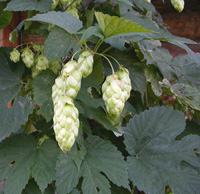|
|||
|
Philatelia.Net / Beer / Plots / The directory «Plots»HopThe Latin name for the hop is Humulus lupulus' or wolf of the woods. It is a tall climbing plant and is one of a small number of species that is distantly related to the cannabis plant i.e. hemp, the nettle and the elm. The plants are dioecious, which means that the males and females flower on separate plants, and only the females bear the hop cones required in the brewing process. The plants are perennials, produced from cuttings, and can be expected to remain productive for 10 - 20 years or more, sending their roots down to a depth of up to 12 feet (3.75 m). Each year they die back to ground level and regrow in the spring, with the support of string and poles, to a height of at least 16 feet (5 m). Each hop variety originates from an individual seedling, and the plant breeding programme of Horticulture Research International (HRI) at Wye in Kent specialises in producing crosses that yield new strains of hops with good brewing and growing characteristics. The hop is an essential ingredient in that most natural of processes, brewing, providing nature's solution to the bittering, preservation and flavouring of beer. 822 AD The first reference to hops is a document by the Abbot Adalhard of Corvey (Westphalia, Germany) releasing the millers from their duty of gathering hops and malt. Despite this early reference, hops did not come into general use in brewing until the end of the 15th Century, at which time the brewing techniques used in Flanders found their way to Britain. 1450 AD The presence of hops in beer was accused of stirring up Jack Cade, a Kent man with the alias 'john Mortimer', to launch his ill-fated rebellion against corruption. Despite his hop- inspired victory over government forces at Sevenoaks and his alias's subsequent pardon from King Henry VI, this did not save Cade from being hunted down in his own name and mortally wounded by the Sheriff of Kent. 1520 AD The weavers of Flanders settled in Kent to take advantage of that county's prosperous wool industry and brought with them new varieties of hops and the knowledge of how to use them effectively in beer. Several centuries passed between the introduction of hops into England and their acceptance in standard brewing technique. Traditional Ales such as Burton Ale, which have been famous since the 13th Century, were still brewed without hops at the time of Henry VIII. ‘Ale’ at that time denoted strong, sweet brews of malted barley flavours with spices , herbs and bark of trees. The more recent drink of ‘beer’, which Henry VIII effectively outlawed by banning the use of hops in brewing, remained in abeyance until his son, Edward VI, passed special legislation in 1552 to permit the use of hops again by British brewers. 1710 AD Duty was imposed on hops for the first time and bittering materials other than hops were excluded. Smuggling of hops became a valuable pastime. Belgium, 1986, Hops, Glass of Beer and Barley Belgium, 2008, Hof festival, Asse Costa Rica, 1954, Beer Czechoslovakia, 1938, Armament Factories Czechoslovakia, 1956, Picking hops Czechoslovakia, 1961, Hops and beer Czechoslovakia, 1961, Pilsen and a bottle of beer Czechoslovakia, 1962, Agricalture products (hop) Czechoslovakia, 1965, Zatek - center of hop German Federal Republic, 1998, Harvesting Hops Mexico, 1991, Glass of beer, Hop Yugoslavia, 1955, Hop Yugoslavia, 1981, Hop Austria, 1995.10.07, Belgium, 1972.09.17, Belgium, 1974.04.13, German Federal Republic, 1990.01.02, German Federal Republic, 1993.05.20, German Federal Republic, 1998.07.16, Germany, 1942.02.11, Great Britain, 2003.08.12, Great Britain, 2003.08.12, Czechoslovakia, 1952, Czechoslovakia, 1961, Advertising: |
|||
© 2003-2025 Dmitry Karasyuk. Idea, preparation, drawing up
|

